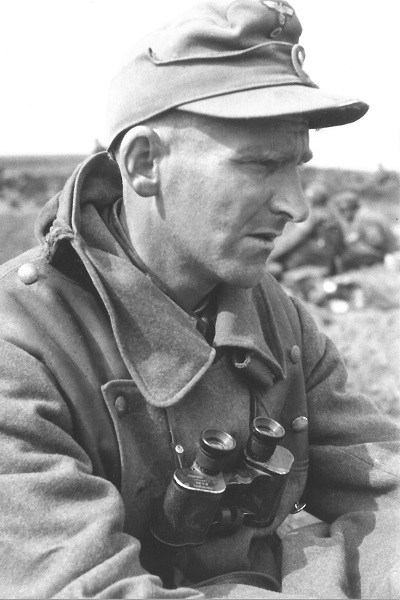Groth, Heinz (Gebirgs-Jäger-Regiment 98)
- Date of birth:
- January 8th, 1906 (Hannover/Hannover, Germany)
- Date of death:
- April 28th, 1994 (Sonthofen, Germany)
- Nationality:
- German
Biography
Promotions:
October 1st, 1942: Hauptmann d.R.;
April 1st, 1944: Major d.R.
Career:
August 26th, 1939: Zg.Fhr. 12./Geb.Jg.Rgt. 99;
November 1st, 1940: Ord.Offz. III./Geb.Jg.Rgt. 99;
December 20th, 1940: Ord.Offz. Stab/Geb.Jg.Rgt. 99;
September 20th, 1941: Chef 13./Geb.Jg.Rgt. 99;
June 10th, 1942: 01 1. Geb.Div.;
February 2nd, 1943: Stab 1. Geb.Div.;
July 1st, 1943: Adj. Stab 1. Geb.Div.;
April 18th, 1945: Rgt.Fhr. 1. V.Geb.Div.
May 8th, 1945: US POW
July, 1945: released
Do you have more information about this person? Inform us!
- Period:
- Second World War (1939-1945)
- Period:
- Second World War (1939-1945)
- Awarded on:
- October 27th, 1939
According to other source the awarding date is 1-10-1939.
- Period:
- Second World War (1939-1945)
- Awarded on:
- July 24th, 1940
- Period:
- Second World War (1939-1945)
- Awarded on:
- December 4th, 1940
According to other source the awarding date is 1-11-1940.
- Period:
- Second World War (1939-1945)
- Awarded on:
- March 4th, 1942
- Period:
- Second World War (1939-1945)
- Rank:
- Oberleutnant (1st Lieutenant)
- Unit:
- Chef, 13. Kompanie, III. Bataillon, Gebirgsjäger-Regiment 99, 1. Gebirgs-Division, Heer
- Awarded on:
- April 2nd, 1942
According to the Karteikarte awarded on 11-4-1942.
According to other source the awarding date is 13-4-1942.
- Period:
- Second World War (1939-1945)
- Awarded on:
- August 20th, 1942
- Period:
- Second World War (1939-1945)
- Period:
- Second World War (1939-1945)
- Awarded on:
- August 26th, 1942
- Period:
- Second World War (1939-1945)
- Rank:
- Major
- Unit:
- Div.Adj., 1. Gebirgs-Division, Heer
- Awarded on:
- December 27th, 1944
5074th Award.
- Period:
- Second World War (1939-1945)
- Rank:
- Major der Reserve (Major of Reserves)
- Unit:
- Div.Adj.u.Fhr., Gebirgsjäger-Regiment 98, 1. Volks-Gebirgs-Division, Heer
- Awarded on:
- May 9th, 1945
“Major Groth, Adjutant in the 1. Volks-Gebirgs-Divison, was made commander of Gebirgs-Jäger-Regiment 98 during the night of the 14./15.03.1945 by the divisional commander. At this time the Regiment’s attack in the so-called ‘Boot Wood’ (located to the northwest of Somogyzentpal) was threatening to run out of steam. However he mastered his exceedingly difficult task with unusually bold leadership, inspiring élan and exemplary bravery. In doing so he exceeded the expectations being held of him.
Always leading from the foremost line, he threw himself into his duties and managed to reorder his units on the same night he received command of the Regiment. The next day Groth would succeed in capturing the Weinberg hill. Then, in the evening hours, he launched an attack at the head of his troops in conjunction with Gebirgs-Jäger-Regiment 99 against the heavily fortified village of Somogyszentpal. The village was stormed, and on the next day (16.03.1945) Groth would go on to roll up the enemy frontline in his sector from the north in a swift attack.
The enemy recognized the impending danger from the north posed by our enveloping attack, and thusly struck back with the bulk of their 32nd Guards Mechanized Brigade along with Tank-Regiment 52. They pushed the Gebirgs-Jäger-Regiment 99 (attacking on the left of Groth’s Regiment) out of Nagy, and in the process the regimental commander was badly wounded. Correctly identifying the crisis situation for what it was, Major Groth made the bold decision to immediately initiate a counterattack against the enemy flank with his 2 heavily depleted Bataillonen and the Sturmgeschützen of the Sturmgeschütz-Brigade 191 (who had only just arrived in the nick of time). This not only brought the necessary relief to the Gebirgs-Jäger-Regiment 98, but also led to a full success which included the destruction of 9 T-34s and 4 self-propelled guns.
Without waiting for the trailing Gebirgs-Jäger-Regiment 99, he finally launched a daring pursuit thrust on the same day, even though his men were at the limits of their strength after all the effort they had expended. After he had made the correct decision to subordinate the Aufklärungs-Abteilung 54, which was attacking on his right, he and his troops launched a night attack against Csömend. This village, important for the entire operation, was also captured. With that his string of leadership successes culminated in a militarily decisive victory. Although he himself was wounded during this engagement, he stayed with his 2 consolidated Bataillonen. He would go on to repulse a strong enemy counterattack (preceded by unusually violent artillery preparation) against Csömend in the morning hours of the 17.03.1945, and would only give himself up to medical care after his success had been consolidated and a replacement for him had arrived on the battlefield.
Successes of these days:
a. The smashing of strong elements from the 32nd Guards Mechanized Brigade along with elements of the Rifle Regiments 55 and 57.
b. Enemy losses and captured materiel amounted to:
158 counted enemy dead
110 estimated enemy dead
46 light machine-guns
22 heavy machine-guns
14 anti-tank rifles
5 anti-tank guns (4.7 cm)
6 artillery pieces (7.62 cm)
5 artillery pieces (12.2. cm)
10 T-34 tanks
4 self-propelled guns
2 tractors.”
His nomination by the troop was received by the Heerespersonalamt (HPA—Army Staff Office) on 23-3-1945. The book "Verliehene Ritterkreuze" (Awarded Knight Crosses) contains a note (presumably by Joachim Domaschk): "Knight's Cross no, Honour Roll". The file card states: "rejected" and "unfinished (Honour Roll)? ". The presentation date was assigned by Walther-Peer Fellgiebel.
Sources
- Photo 1: Known to STIWOT
- - DÖRR, M., Die Inhaber der Anerkennungsurkunde des Oberbefehlshaber des Heeres 1941-1945, Biblio Verlag, Osnabrück, 1993.
- FELLGIEBEL, W.P., Elite of theThird Reich, Helion & Company Limited, Solihull, 2003.
- PATZWALL, K. & SCHERZER, V., Das Deutsche Kreuz 1941-1945, Verlag Klaus D. Patzwall, Norderstedt, 2001.
- THOMAS, FRANZ & WEGMANN, GÜNTER, Die Ritterkreuzträger der Deutschen Wehrmacht 1939-1945.
- Axis History Forum via Awardholders / unit
- NARA Roll T-78 R886
- BArch RH 7/370.














